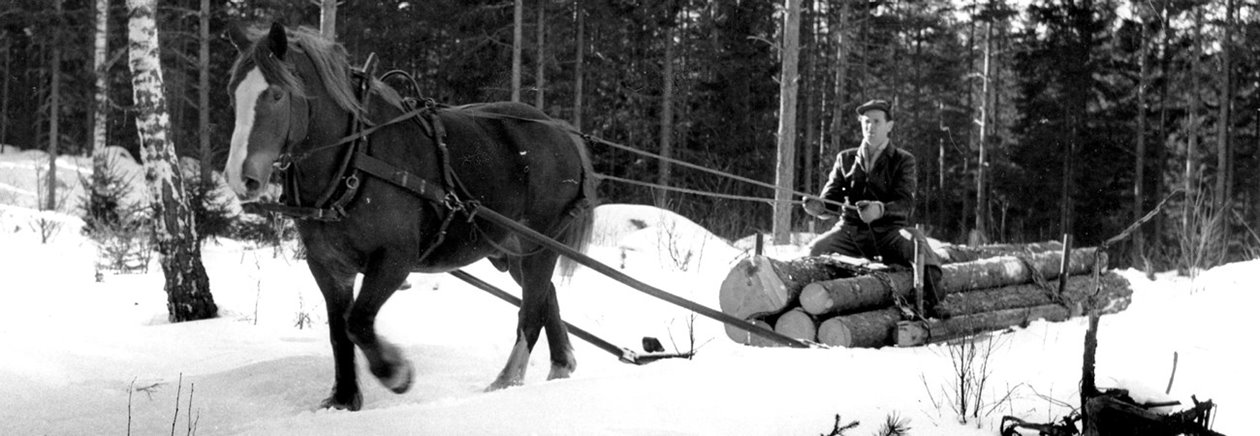A history of commitment and expansion

The need to get a good price on the market for forest raw materials has been a major driving force ever since the beginning in the 1920s.
In 1926, Smålands Skogsägareförening was formed through the merging of county associations. This was to be the first of a number of mergers and this trend has continued and caused Södra to grow geographically. As recently as on 1 January 2007, Bohuslän and Dalsland became part of Södra.
It begins in 1938
Södra is usually seen as having its beginnings in 1938, when Sydöstra Sveriges Skogsägareföreningars Förbund was formed. At that time Södra was also an economic association, something that has been important for its development.
During the Second World War, Södra played a significant role in Sweden's energy supply. It was not just firewood for heating houses that came from Södra's forests. Södra also contributed raw materials for the wood-gas generators that propelled cars, buses and other vehicles in wartime.
When the war came to an end, oil was once again imported into Sweden. And now not just for propelling vehicles. Heating using oil became common and demand for firewood as a fuel reduced.
Own pulp mills
The needs of the sawmills did not provide a sufficiently big market for the increasing growth in the more and more professionally run forests. Södra's MD, Gösta Edström realised that it would be necessary to start their own pulp mills in order to create a market for forest raw materials. He pushed through this investment in new industry, which is still Södra's core today. For many years, he was both the great visionary and the great implementer in Södra's leadership.
The pulp mills were located at Mönsterås, Mörrum and Värö. They were inaugurated in 1959, 1962 and 1972. Södra had become a successful forestry group with an international market. Sales offices were built up in a number of countries.
Financial crisis
After a decline at the end of the 1970s and beginning of the 1980s, the government intervened and took over 40 percent of shares in the industrial section. By 1985, the situation had stabilised and Södra was able to redeem the government's shareholding.
Production in Södra's industries was high in the 1990s and early 2000s, and profitability increased. Södra grew when forest owners from Skåne, Skaraborg, Bohuslän and Dalsland joined the association and a number of industries were acquired.
Energy production and research began to take on more importance towards the end of the 2000s. Södra is facing ever-increasing competition on the market, and finding new ways of using wood will pose a major challenge for the future.
Major industrial investment
In 2013, the Board adopted a new Group strategy focused, in part, on improving growth by investing in increased pulp production, primarily at the pulp mill in Värö. In 2016, a new pulp mill with a capacity of 700,000 tonnes was opened in Värö.
History of the pulp mills
After WWII, the need for firewood declined. The question was what the forest owners should do with all their wood, particularly the pulpwood. The forest industry in Southern Sweden was too small; it put a damper on consumption and the price of wood.

The forest companies felt that there was not enough wood for pulp production, but Södra’s founder and President Gösta Edström was of a different opinion. He felt that there was more than enough, too much wood in fact, and he was prepared to take the matter into his own hands and expand the pulp industry.
When the plans for a factory in Mönsterås were presented to the board in January 1952, funding was limited. But Södra, thousands of forest owners throughout the country and their associations, financed the share capital of SEK 50 million. The first pulp was manufactured in Mönsterås in 1958.
This was the start of Södra’s involvement in cellulose. Bold ventures throughout the years have paid off in the form of higher wood consumption and prices and good profitability in mills. Profits built the company and been shared with the owners.
But it was no easy feat to reach consensus with all the Mönsterås mill owners. The solution was for Södra to assume sole responsibility for the mill, which was expanded, bit by bit. In the 1970s, a completely new facility was built and more additions added in the 1990s.
Competition with Wallenberg’s forest company was tangible when the Mörrum mill was planned. Södra had already purchased land, but more was needed and acquired in friendly competition with Wallenberg who retreated and built in Nymölla instead.
A sizeable charge of dynamite marked the start of construction in December 1959. The first pulp was produced 17 months later. Prince Bertil opened the mill in 1962 in front of more than 6,000 guests. Gösta Edström stressed the significance of the mill:

“Those who remain raw material producers and lack the fortitude to advance into processing are doomed to the ranks of the underdeveloped. This mill is just a milestone. More is yet to come,” was the message from Edström who had Värö in mind.
But Mörrum would be the first to expand. In 1970, there were separate lines for softwood pulp and hardwood pulp, 300,000 tonnes per year.
The addition of the Värö pulp mill was related to the merger of the area’s forest owner associations, whose members needed to sell their wood. It would be a while before the mill was completed, however. Intense opposition came from many directions. Environmental activists gained momentum, and debates and protests took time. Authorisation from the authorities and court proceedings went on for many years.
Nonetheless, test operations started in the summer of 1972 and the opening ceremony followed. 220,000 tonnes were produced just one year later.
In the summer of 2000, the Norwegian pulp mills Tofte and Folla were acquired from Norske Skog. Södra was now the third-largest pulp supplier in the world with more than 2 million tonnes a year in total. The company was in the lead in terms of softwood pulp.
Södra still develops new pulp grades and production of a completely new Södra product – dissolving pulp – started at the Mörrum mill in 2012.
In the autumn of 2012, Södra decided to phase out operations at the Folla pulp mill and, a few months later at the beginning of 2013, it was announced that also ownership in the Tofte pulp mill was to be phased out.
In 2014, Södra’s Board decided to carry out the largest industrial investment in Södra’s history – the Expansion Södra Project. A total of SEK 6 billion was invested in the company’s three pulp mills: SEK 4 billion to increase Södra Cell Värö’s annual pulp production capacity from 425,000 to 700,000 tonnes; just over SEK 1 billion to increase the capacity in Mörrum by 45,000 tonnes, bringing the total production of paper and dissolving pulp to 470,000 tonnes; and just over SEK 300 million to enable more efficient energy use and increased productivity at the mill in Mönsterås.
In September 2016, an essentially brand new pulp mill was opened in Värö – one of the largest in the world when it comes to the production of softwood sulphate pulp. Thanks to the billion-kronor investments being carried out under the Expansion Södra Project, Södra’s pulp mills will have a total production capacity of 1.9 million tonnes by 2020.
History of the sawmills
Södra acquired its first sawmill as early as 1943 and there have been many more since. Södra has today evolved into one of the country’s largest sawmill companies.
The Kinda sawmill initiated a new era for sawmills in southern Sweden through its sheer size and technology. Completed in 1968, the sawmill was a response to requests from the province of eastern Götaland for a sawmill to take care of the surplus of logs. The need to sell sawlogs has always been the underlying reason for investments in sawmills. Sawlogs account for the largest portion of forestry income; the price is extremely important.
But Södra’s sawmill history started in 1943 with the take over of a sawmill in Hallbro, Blekinge County. It was no more remarkable than any of the other sawmills that Södra would come to operate, but it was the first. Over the years, ownership of sawmills has fluctuated. Most of the mills from the early years have been shut down and replaced by larger facilities.
The Värö sawmill started in 1974, next to the then two-year old pulp mill. The intention was to effectively manage the members’ forest raw material in the combined facility. Mönsterås became the next combined facility; in 1999 a sawmill was built next to the pulp mill. With a capacity of 400,000 cubic metres, it was Södra’s largest. In 2002, four sawmills and five plants for producing wood products were acquired from the family-owned company Geijerträ.
In the autumn of 2011, the new Värö saw opened with a capacity of 600,000 cubic metres.
After several years of intensive efforts to achieve a profitable sawmill business, Södra decided in 2016 to implement a restructuring package involving the closure of the softwood sawmills in Ramkvilla and Torsås, the closure of the hardwood sawmill in Djursdala and the acquisition of the UK sawn timber products distributor Crown Timber.
The financial crisis
The Swedish government came to company’s aid during the financial crisis by becoming a 40-per cent owner in 1979. But once the difficult years were over, profits skyrocketed and in 1985 Södra was again wholly owned by its members.

Södra was in a financial crisis at the end of the 1970s. The economy was weak. Losses were substantial, particularly in industries that had been acquired just a few years earlier and in the wood products industries. Moreover, the ongoing construction of a new pulp mill in Mönsterås demanded vast amounts.
The financial crisis was resolved when the Swedish government stepped in with SEK 500 million and became 40-per cent owner of Södra’s industrial company in 1979. Half of the members left the association. A weak economy and losses defined the three years that followed. Major changes were necessary if the company was to survive the crisis.
During the period 1979 to 1983, three pulp mills, two paper mills and equally as many sawmills were closed. Two paper mills, one sack paper factory, one sawmill and one house factory were sold. The MDF division of a jointly owned company was shut down. The company’s forest land and power stations were sold. In addition, rationalisations were made in many units. The number of employees at Södra plummeted from more than 10,000 in 1976 to 2,500 in 1994.
These were difficult years, but they laid the foundation for a better future. Profits skyrocketed and Södra was able to redeem the government’s shares. An arbitration board set the price, SEK 750 million.
The formal take-over took place on 2 January 1985. Södra was once again wholly owned by its members. “Immensely satisfying,” commented Södra’s Chairman Archibald Dickson when he closed the deal in Stockholm and brought the shares home.
Södra is member-owned
As of 1985, the members again owned Södra and the company’s objective was the same as it was at the start: to facilitate the sale of wood at reasonable prices.

A new era of Södra’s history began when the Swedish government’s five-year ownership came to a close and the forest owners were again their own masters. Södra has more than 50,000 owners today.
Economic association, cooperative, forest-owner association and group. Whatever the form, they are all Södra. The members run their companies to help boost the profitability of their forest estates. Every member has one vote, regardless of the size of their forest estate or capital.
As it was from the beginning, Södra’s mission is to improve the profitability of members’ forest estates. Members sell their wood till Södra. But the business does not end with the price of the wood. The members are more than wood suppliers; they are also part-owners of Södra’s industries and receive part of the profit generated by these industries.
Every year, a proportion of Södra’s profit goes back to its members. The members take part via contributed capital that is deducted from payments for their wood. How much of the profit each member receives is based on contributed capital and wood deliveries to Södra over the year. Each time members sell wood to Södra, the contributed capital grows, entitling to a proportion of future profits.
The new era has been a time of reaping that which has been sown. Besides being able to sharply increase profit dividends, capital has been transferred from the company through bonus issues. Through this, the owners have gained billions of Swedish krona while simultaneously developing and consolidating their company.
Hurricane Gudrun
Never before has a hurricane felled so much forest as Gudrun did during her tour of southern Sweden in 2005.
Meteorologists had warned about the storm on 8 January 2005, but it was far worse than anyone could imagine. Almost four years’ worth of harvesting work was felled in a few hours. In many places, more than ten years’ worth of harvesting lay on the ground.
Forests had suffered severe damage from storms in the past, but never to such an extent. But history foretold that Södra in a time of crisis would be able to allocate resources and also weather this catastrophe. The innate strength of the organisation and its members was clear for all to see after hurricane Gudrun’s rampage.
Equal pay principles were quickly adopted. Support from the community to those particularly hard hit was secured, the organisation’s resources were heavily reinforced, timber terminals were set up and Södra’s own industries maximised their use of storm-felled timber. The members could feel secure.
The outcome was better than anticipated and the experience vastly added to the organisation’s knowledge about dealing with the aftermath of a storm. Insight that proved valuable just two years later when Cyclone Per passed over, albeit not as savagely as Gudrun.
Södra’s history would not be complete without storms – and the latest ones will certainly not be the last.
Södra throughout the years
1920
There was a time when trees were a scarce resource in the south of Sweden. A modern Forestry Act changed all that.
1938
Sydöstra Sveriges Skogsägareföreningars Förbund is formed, marking the start of Södra.
1940
A tar and turpentine factory in Lenhovda becomes Södra’s first industry. Turpentine is used as fuel in the company’s cars during WWII and ten wood-gas trucks are also purchased in this year.
1942
Business is good for Södra. The association now has 23 district offices with forest inspectors.
1943
Södra acquires its first sawmill in Hallabro, Blekinge County.
1944
The purchase of Svenska Idealhus in Hultsfred and another two wood-products industries lays the foundation for Hultsfreds-Hus, which eventually became one of Sweden’s largest prefabricated house factories. Södra owns Hultsfreds-Hus until 1981.
1948
Södra has 19,000 members. Sydsvenska virkesföreningen wants to lower wood prices and Södra discloses for the first time its plans to build a pulp mill.
1952
Södra continues to grow. Membership now exceeds 20,000 and fund-raising activities for the pulp mill in Mönsterås commence.
1953
Sydöstra Sveriges Skogsägares Förbund is formed through a merger. As part of this move, the county associations dissolve and Södra becomes the umbrella company for all forest owners.
1954
Södra is now a large company with revenue in excess of SEK 100 million and more than 1,500 employees. The company has almost enough money to realise its industrial plans.
1956
Södra’s first forestry district offering members forest management assistance is formed in Linneryd. Several similar districts were formed in subsequent years.
1958
Södra directs its focus on pulp production 20 years after the idea first surfaced. Production takes place at the new pulp mill in Mönsterås.
1962
Södra opens another pulp mill, this time in Mörrum.
1964
Södra Sveriges Skogsägares Förbund is formed through a merger of the associations in Halland, Jönköping and Södra Älvsborg. The forest owners intensify their strength in one fell swoop.
1966
An industrial package is presented encompassing several projects to boost consumption of forest raw material, including a pulp mill in Värö on the Swedish west coast, takeover of the pulp mill in Mönsterås, doubling of pulp production in Mörrum, an MDF factory in Hultsfred and a sawmill in Kinda.
1968
Södra’s new head office in Skogsudden, Växjö, is completed on time for the start of a new epoch in Södra’s sawmill history.
1970
Revenue surpasses the SEK 1 billion mark, of which exports accounted for SEK 400 million. A flurry of business activities ensues, including a new birch pulp line in Mörrum and the construction of a new pulp mill in Värö.
1972
The pulp mill in Värö is inaugurated and Södra now has more than 1,100 forest workers. Workers no longer have to buy their own chainsaws, but are instead allowed to use those provided by Södra.
1973
The winds of change blow when Gösta Edström steps down as Chairman of Södra after four decades at the helm of the forest-owner movement. Meanwhile, the unions take seats on the board for the first time.
1974
The Värö sawmill starts production.
1976
Södra acquires more industries, including Klippans Finpappersbruk. The majority of these will be sold or phased out to resolve Södra’s financial crisis.
1979
Södra Skogenergi is formed to develop biofuel production, primarily using logging waste and peat. An emergency solution to the financial crisis is reached and has a happy ending.
1981
Following many years of producing its own MDF, Södra joins with Statens Skogsindustrier and Swedish Match to form Swedspan, an MDF company. This was the beginning of the end of Södra’s involvement in the MDF industry. In just a few years’ time, Södra will have relinquished all ownership.
1983
Good times: losses morph into strong profits and Södra handles timber volume in the range of 6 million cubic metres.
1985
The financial crisis comes to a close when Södra buys back the Swedish government’s 40-per cent ownership in the industrial company. The members are once again the owners and have control of Södra.
1988
Modern times! Södra equips its forest inspectors with car phones.
1990
Timber volumes at Södra grow steadily – the figure is now 8 million cubic metres and the equity ratio is at a healthy 40 percent. Hard times are ahead, however, accompanied with cutbacks in the workforce.
1992
Despite the high production rates of Södra’s industries, prices for pulp and timber products are low. Nevertheless, Södra expands when Skånes Skogsägare joins the association.
1994
Södra forms a company for timber imports from the Baltic States: Södra Eesti.
1995
A good year for Södra – sound profitability with a 33-percent return on capital employed and SEK 100 million earmarked for a newly created research foundation to benefit the forests in Southern Sweden.
1999
Forest owners in Skaraborg are offered membership when their association is dissolved and the Mönsterås sawmill starts operations.
2000
Södra acquires the Norwegian pulp mills Tofte and Folla.
2002
Four sawmills and five factories for producing wood products are acquired from Geijerträ. The transaction includes Gapro, a manufacturer of products such as mouldings, panelling and flooring. The business has grown gradually, and new plants have been acquired in Sweden, Norway and Denmark.
2003
Södra’s positive performance continues with healthy dividends to members: SEK 449 million and SEK 152 million as a bonus issue. The timber volume is 15 million cubic metres.
2005
Hurricane Gudrun strikes on 8 January. Southern Sweden suffers the brunt as Gudrun cuts a path of devastation, felling forests for many members. Södra handles some 24 million cubic metres of wood.
2007
Bohuslän and Dalsland decide to leave Mellanskog and become part of Södra’s operations. Forest owners in both counties are offered membership.
2008
Energy production and research operations are becoming increasingly important for Södra’s business and future.
2009
Timber house producer Trivselhus becomes part of Södra.
2011
The new Värö sawmill is inaugurated and manufacturing of dissolving pulp starts at the Mörrum mill.
2012
The decision to phase out ownership of Södra Cell Folla in Norway is taken.
2013
Södra celebrates its 75th anniversary!
The decision to phase out ownership of Södra Cell Tofte in Norway is taken.
The decision was taken to make a major investment (SEK 6 billion) in the Group's three pulp mills.
2014
Two former business areas, Södra Timber and Södra Interiör, merge to become Södra Wood.
2016
Södra's restructuring of its sawmill business resulted in the closure of the softwood sawmills in Ramkvilla and Torsås, the closure of the hardwood sawmill in Djursdala and the acquisition of the UK sawn timber distributor Crown Timber.
A new pulp mill with a capacity of 700,000 tonnes was opened in Värö.
